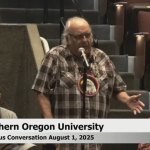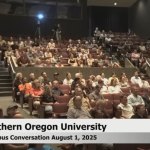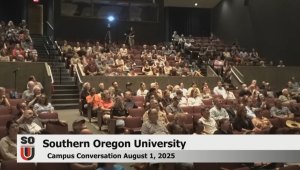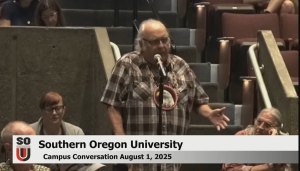Bailey says SOU ‘building’ to a $60M university, 15% off current budget; athletics could lose $1.1M
Published 9:53 am Sunday, August 3, 2025




Draft plan estimates cuts of $10.5 million over two years and 64 FTE positions; moves to cut 15 majors, Native American Studies minor; $1.1 million from athletics
Southern Oregon University President Rick Bailey unveiled a provisional plan of action Friday to respond to a structural deficit at the higher education institution, declaring exigency on the campus, with draft plans to cut $10.5 million over the next three to three and half years; reduce staff by 64 positions, approximately half of which are considered layoffs.
The plan also includes cutting the university’s 38 academic majors to 23, cutting the Native American Studies minor and the Athletic Department by more than $1 million.
Trending
As far as Bailey knows, SOU is the only university currently declaring exigency in the state, a process he describes as a contractual clause between the university and its faculty union. Although SOU closed for 17 years between 1909 and 1926, Bailey said he doesn’t know if the university has ever declared exigency before. The university will make $5 million in cuts this year, with the rest spread out over the course of upwards of three and a half years.
“We were scheduled to be an institution that was going to spend $71 million,” Bailey told attendees of a campus conversation Friday morning at SOU’s Recital Hall.

Faculty, staff and students filled SOU’s Recital Hall on Friday for a “campus conversation.” Screen capture from YouTube video
Bailey said with $28 million in state funding, more than half of which is allocated for retirement and medical benefits for employees, “there was no way we were going to be able to do that.”
On June 20, SOU’s Board of Trustees directed Bailey to cut $5 million from the budget, but after further review that amount would have only “solved this year’s state budget problem,” Bailey said.
“So we realized that’s not going to work, and in discussions with our union partners, we knew that what we were going to do just to do $5 million was going to require exigency,” Bailey said.
“And so we said, if we’re going to transform, we’d better transform, like really.”
Trending
The planned-or cuts were doubled to $10 million over the course of two years.
“The challenges that we face as an institution and the things that we’re going to have to do to transform are so big that this pathway was the only way through it,” Bailey said. “And so today, we are declaring as an institution exigency. It’s going to allow us to do the transformative things that we need to do as an institution.
“We’re not closing, it’s not bankruptcy, it isn’t even close to that,” Bailey said, “but it’s a mechanism that allows for transformation.”
Seventy pages of feedback from faculty and staff were compiled before Bailey created the current draft plan of action.
“I read every word,” he said, “a lot of our leaders read every word.
“The things that you said affected this plan,” he said.
Bailey shared details of a 23-page “Toward a (more) Resilient SOU” plan in a campus conversation with employees at SOU’s Recital Hall Friday morning.
He unveiled the following $10.46 million in cuts to the university:
- President’s Office: $503,254
- Provost’s Office: $920,451
- College of Arts & Humanities: $1,636,240
- College of Natural & Social Science: $1,376,387
- School of Business: $150,000
- School of Education: $450,408
- Hannon Library: $255,850
- Student Affairs: $137,298
- University Advancement: $462,695
- Finance & Administration: $457,118
- Intercollegiate Athletics: $1,098,434
- Additional Remissions: $2,015,000
- Contracts: $1,000,000
- Total reductions: $10,463,135
“This is how cost savings are being generated and you can see it’s kind of being taken from everywhere,” Bailey said.
The university plans to cut 9.65 classified employees, 25.80 unclassified employees, and 29 faculty — a total of 64.45 full-time equivalents (FTEs) — according to the provisional plan.
“This is our best perspective right now,” he said.

A table from SOU President Rick Bailey’s presentation details budget cuts to take effect over the next few years, mostly in the first year.
Details of this plan are subject to change by late August, Bailey said.
“64 (reductions) is a lot,” Bailey said. “When we went through SOU Forward, it was 82 (reductions), but a lot of that were vacancies or retirements or other things, so 64 is I think a lot harder in terms of affecting people.”
Bailey noted the following percentages as they pertain to the reduction total:
- 17% of the 64 positions are vacant positions not actually affecting individuals
- 19% of those cuts represent a change in funding source to the position, where the individual can stay on staff
- 25% of cuts represent individuals with an intent to retire
- 32% of cuts represent positions that are being eliminated, affecting those individuals directly
Approximately $10.5 million in savings will be incremental, over the course of three to three-and-a-half years, Bailey said.
“Ultimately, SOU needs to be a smaller university to work within a framework where revenues are always greater than expenses,” the draft plan reads. “As challenging as this work is, we need to envision a smaller, more resilient university – one that can withstand strong headwinds. If SOU FORWARD were to be considered the first of two phases, this current transformation effort would be phase two, which envisions a $60 million university as opposed to our current $71 million university.”
Another adjustment in the provisional plan includes moving the Associate Vice President of Equity, Diversity and Inclusion to a director position working directly with students.
Bailey acknowledged that the symbolism is “problematic” in moving the position from the executive level. He cited the move as more important for SOU to invest resources contributing to an environment where every student feels a sense of belonging than having a senior executive role.
“Every department that is impacted by this plan has had a departmental discussion,” said Bailey, during a Q&A portion of the conversation.
Bailey decried that the university hasn’t been able to invest in strategic ways to bring students to the campus, help students along their path, provide adequate compensation or put funds into reserves.
“We’ve done some amazing things, but they’ve almost always been done through blood, sweat, and tears, not through resources,” Bailey said.
“We’ve never been able to really invest in cool ideas,” he added.
He acknowledged “that the predicament we’re in … it is tied to a lot of things that are outside our control,” Bailey said. “But there are some things that are within our control and we have to own that.”
Bailey said there is a need for a “culture shift,” how to think differently about how the university takes care of its employees and its students.
He noted specifically that a lack of funding to put in reserves puts the university in similar circumstances over and over.
“Because of that we have to do something so crazy just to move forward,” he said. “So something has to change.”
Bailey asked for a show of hands from classified members in the audience.
He noted those who raised their hands had two 1% cost-of-living adjustments (COLA) during the last four years.
“It’s safe to say they’ve taken a pay cut just to stay here,” Bailey said.
Once per month over the course of the last five years, more than 60 higher education institutions have merged, been acquired, or closed, Bailey said.
“Our women’s basketball team played a school that closed that week, so it’s real,” Bailey said. “We have to be very, very sober about the challenges that are facing us.”
Bailey overviewed financial difficulties of the past three decades, starting with the 2000s, a decade with a mantra of “Do more with more.” He said revenues at the time were “pretty good, comparatively,” prompting the university to do a lot of different things.
“That’s OK when you have a lot of resources,” he said.
As resources started to decrease, as well as enrollment, “the state wasn’t matching the increase in all of the costs and yet, we kind of kept marching forward.”
During the 2010s, which Bailey described as a time of “Do more with less,” SOU faculty and staff were told to find ways to increase efficiencies across campus.
Since 2020, the mantra at SOU has been “less with less.”
“The only thing that changed is we have few people to do (the work),” Bailey said.
Bailey praised leaders of the state, but admitted the university must have its own plan.
“They are not coming to our rescue,” Bailey said.
While he has “a lot of hope” that legislators could increase state funding levels, “hope is not a strategy, so let’s do the things that we have to do to protect this institution and make sure that we are thriving for students in the future.”

David West questions SOU President Rick Bailey about cutbacks to Native American studies programs Friday morning in the Recital Hall at SOU. (Screen capture from YouTube video)
Multiple individuals brought questions and comments to the forefront, and among those were three individuals who spoke about the potential loss of the Native American Studies minor.
The minor will become part of a Gender/Women’s Studies and Ethnic and Racial Studies Minor, with continuing classes specifically about Native American Studies, according to Bailey.
“The institution of SOU is on Native land,” one commenter said, during the Q&A portion. “SOU has a land acknowledgement.
“This is where land acknowledgement becomes words.”
Bailey responded that the university is working toward creating a Native American gathering space on campus.
Bailey said it was intentional “to make sure that we were holding onto that program” through continued Native American Studies courses.
“We’re trying to do the best we can to be as respectful as we can,” Bailey said.
In a phone interview with Bailey Friday afternoon, he shared about next steps following the campus conversation.
“We’ve now submitted that provisional plan to the union and they have 20 university days, between now and Aug. 29, (where) they can provide feedback, recommendations, alternatives, suggestions, and we’ll listen to all of it,” Bailey said.
More details
Read the provisional plan: click here
View the campus conversation on YouTube: click here
By the numbers
Majors before: 38
Majors after: 23
Minors before: 35
Minors after: 24
2015 enrollment: 4,108
2024 enrollment: 3,209
Reduction in classified FTEs: 9.65
Reduction in unclassified FTEs: 25.8
Reduction in faculty FTEs: 29.0
Overall budget before: $71 million
Overall budget after: $60 million
If you are personally affected by the potential cuts at SOU, please reach out to Ashland.news reporter Holly Dillemuth at hollyd@ashland.news. This story first appeared at Ashland.news.












